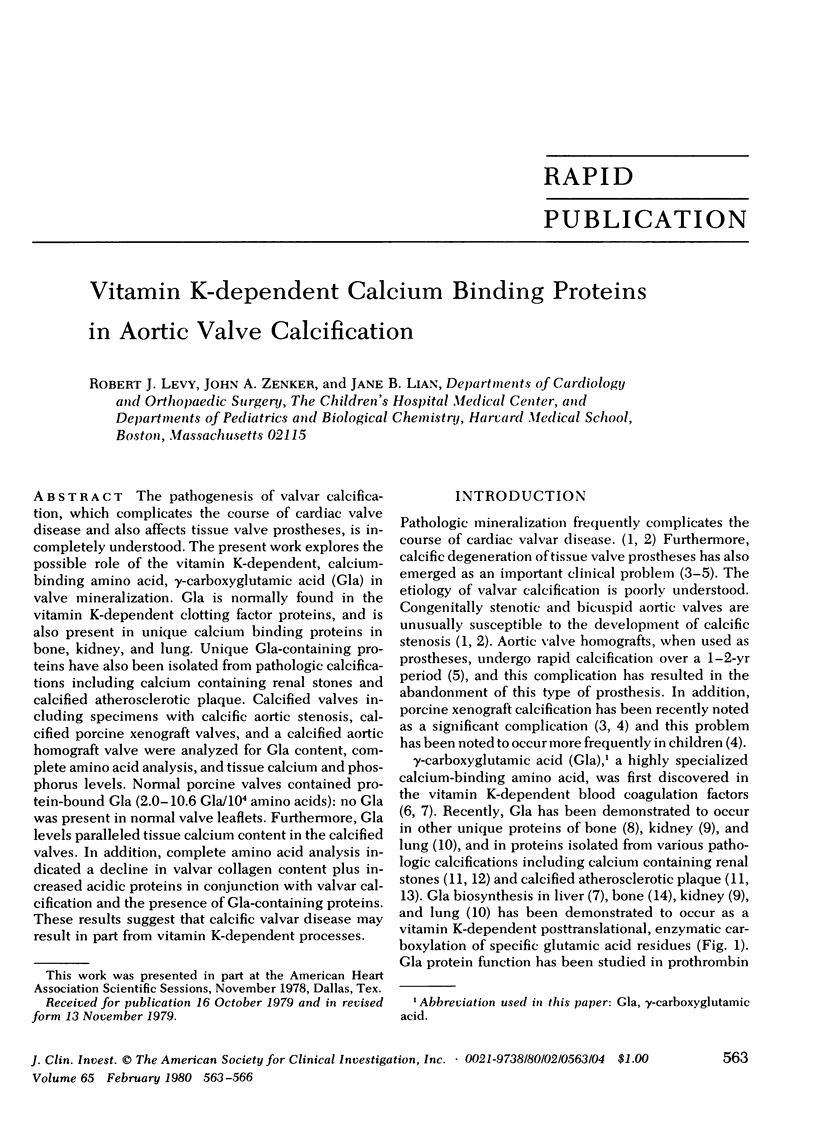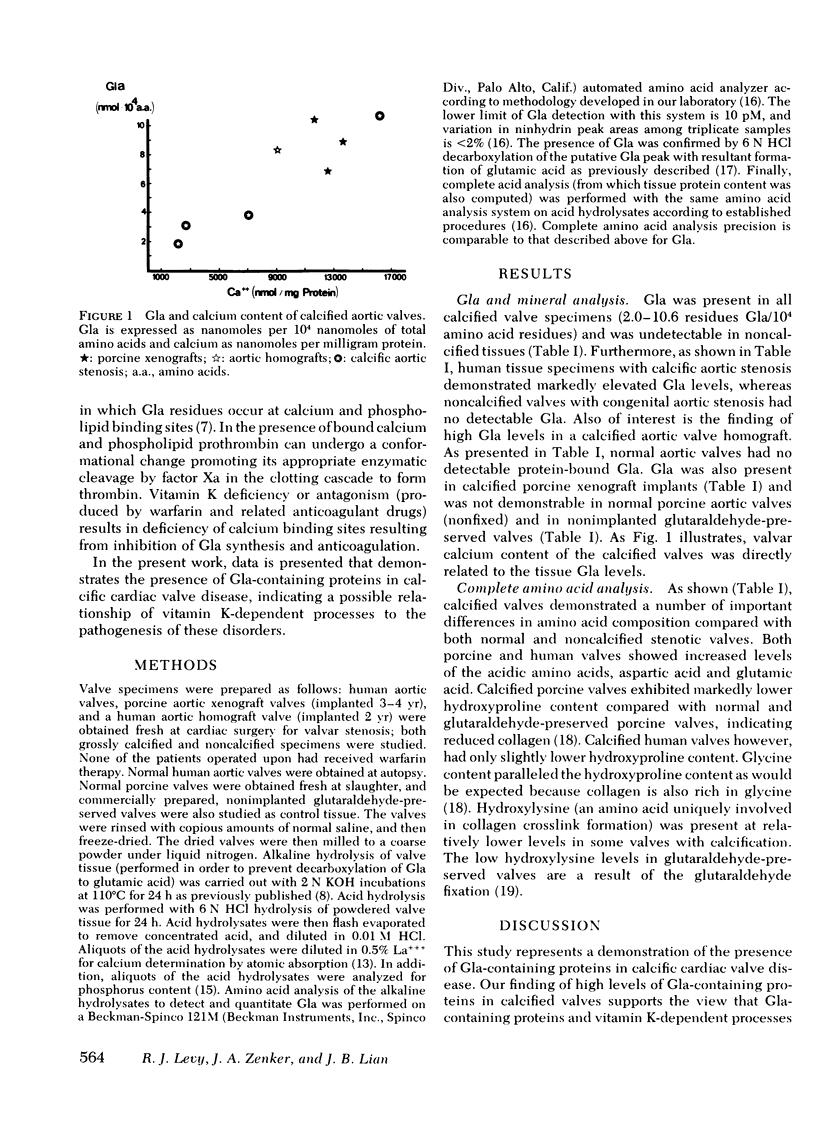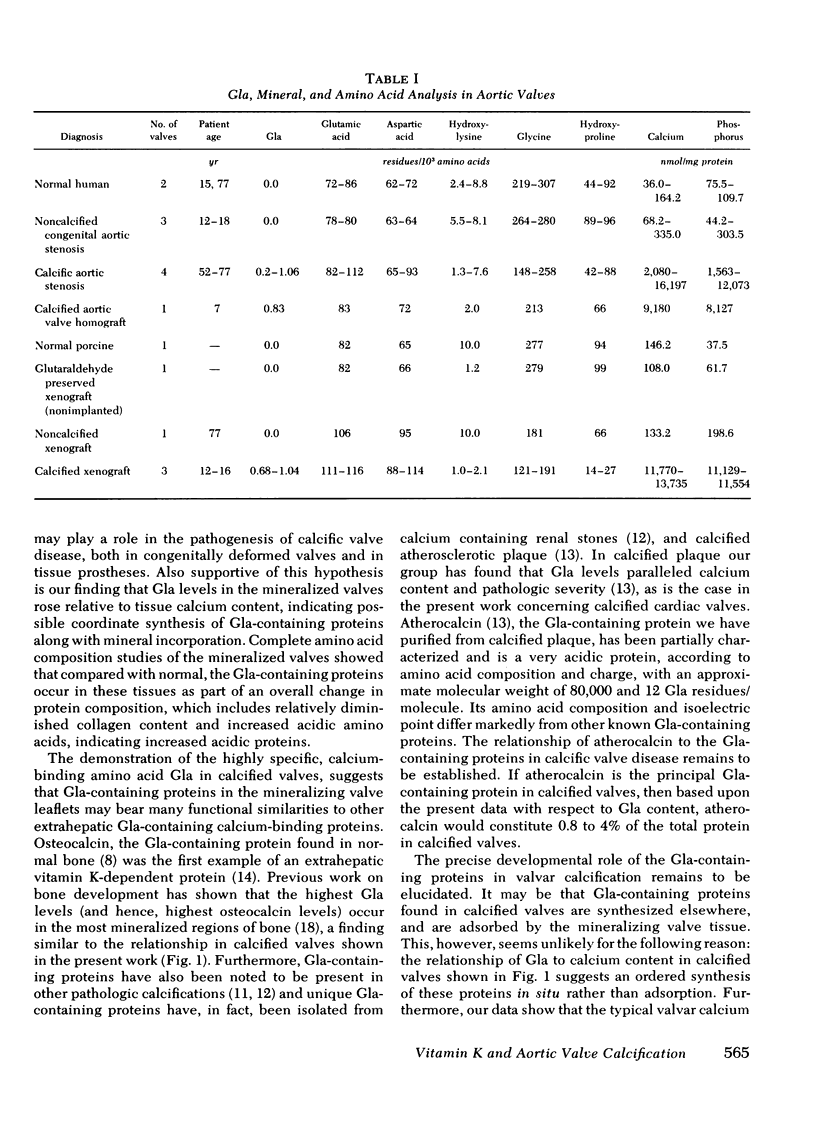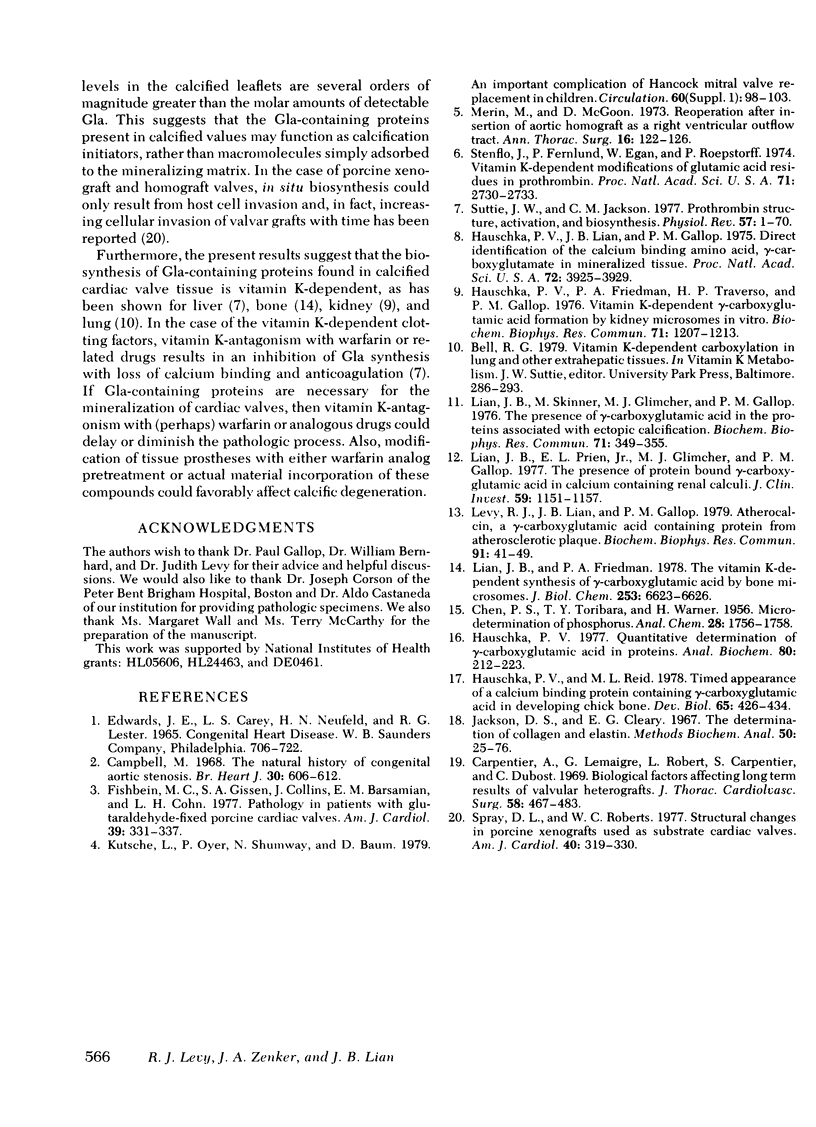Abstract
The pathogenesis of valvar calcification, which complicates the course of cardiac valve disease and also affects tissue valve prostheses, is incompletely understood. The present work explores the possible role of the vitamin K-dependent, calcium-binding amino acid, γ-carboxyglutamic acid (Gla) in valve mineralization. Gla is normally found in the vitamin K-dependent clotting factor proteins, and is also present in unique calcium binding proteins in bone, kidney, and lung. Unique Gla-containing proteins have also been isolated from pathologic calcifications including calcium containing renal stones and calcified atherosclerotic plaque. Calcified valves including specimens with calcific aortic stenosis, calcified porcine xenograft valves, and a calcified aortic homograft valve were analyzed for Gla content, complete amino acid analysis, and tissue calcium and phosphorus levels. Normal porcine valves contained protein-bound Gla (2.0-10.6 Gla/104 amino acids): no Gla was present in normal valve leaflets. Furthermore, Gla levels paralleled tissue calcium content in the calcified valves. In addition, complete amino acid analysis indicated a decline in valvar collagen content plus increased acidic proteins in conjunction with valvar calcification and the presence of Gla-containing proteins. These results suggest that calcific valvar disease may result in part from vitamin K-dependent processes.
Full text
PDF



Selected References
These references are in PubMed. This may not be the complete list of references from this article.
- Campbell M. Calcific aortic stenosis and congenital bicuspid aortic valves. Br Heart J. 1968 Sep;30(5):606–616. doi: 10.1136/hrt.30.5.606. [DOI] [PMC free article] [PubMed] [Google Scholar]
- Carpentier A., Lemaigre G., Robert L., Carpentier S., Dubost C. Biological factors affecting long-term results of valvular heterografts. J Thorac Cardiovasc Surg. 1969 Oct;58(4):467–483. [PubMed] [Google Scholar]
- Fishbein M. C., Gissen S. A., Collins J. J., Jr, Barsamian E. M., Cohn L. H. Pathologic findings after cardiac valve replacement with glutaraldehyde-fixed porcine valves. Am J Cardiol. 1977 Sep;40(3):331–337. doi: 10.1016/0002-9149(77)90154-0. [DOI] [PubMed] [Google Scholar]
- Hauschka P. V., Friedman P. A., Traverso H. P., Gallop P. M. Vitamin K-dependent gamma-carboxyglutamic acid formation by kidney microsomes in vitro. Biochem Biophys Res Commun. 1976 Aug 23;71(4):1207–1213. doi: 10.1016/0006-291x(76)90782-8. [DOI] [PubMed] [Google Scholar]
- Hauschka P. V., Lian J. B., Gallop P. M. Direct identification of the calcium-binding amino acid, gamma-carboxyglutamate, in mineralized tissue. Proc Natl Acad Sci U S A. 1975 Oct;72(10):3925–3929. doi: 10.1073/pnas.72.10.3925. [DOI] [PMC free article] [PubMed] [Google Scholar]
- Hauschka P. V. Quantitative determination of gamma-carboxyglutamic acid in proteins. Anal Biochem. 1977 May 15;80(1):212–223. doi: 10.1016/0003-2697(77)90640-6. [DOI] [PubMed] [Google Scholar]
- Hauschka P. V., Reid M. L. Timed appearance of a calcium-binding protein containing gamma-carboxyglutamic acid in developing chick bone. Dev Biol. 1978 Aug;65(2):426–434. doi: 10.1016/0012-1606(78)90038-6. [DOI] [PubMed] [Google Scholar]
- Jackson D. S., Cleary E. G. The determination of collagen and elastin. Methods Biochem Anal. 1967;15:25–76. doi: 10.1002/9780470110331.ch2. [DOI] [PubMed] [Google Scholar]
- Kutsche L. M., Oyer P., Shumway N., Baum D. An important complication of Hancock mitral valve replacement in children. Circulation. 1979 Aug;60(2 Pt 2):98–103. doi: 10.1161/01.cir.60.2.98. [DOI] [PubMed] [Google Scholar]
- Levy R. J., Lian J. B., Gallop P. Atherocalcin, a gamma-carboxyglutamic acid containing protein from atherosclerotic plaque. Biochem Biophys Res Commun. 1979 Nov 14;91(1):41–49. doi: 10.1016/0006-291x(79)90580-1. [DOI] [PubMed] [Google Scholar]
- Lian J. B., Friedman P. A. The vitamin K-dependent synthesis of gamma-carboxyglutamic acid by bone microsomes. J Biol Chem. 1978 Oct 10;253(19):6623–6626. [PubMed] [Google Scholar]
- Lian J. B., Prien E. L., Jr, Glimcher M. J., Gallop P. M. The presence of protein-bound gamma-carboxyglutamic acid in calcium-containing renal calculi. J Clin Invest. 1977 Jun;59(6):1151–1157. doi: 10.1172/JCI108739. [DOI] [PMC free article] [PubMed] [Google Scholar]
- Lian J. B., Skinner M., Glimcher M. J., Gallop P. The presence of gamma-carboxyglutamic acid in the proteins associated with ectopic calcification. Biochem Biophys Res Commun. 1976 Nov 22;73(2):349–355. doi: 10.1016/0006-291x(76)90714-2. [DOI] [PubMed] [Google Scholar]
- Merin G., McGoon D. C. Reoperation after insertion of aortic homograft as a right ventricular outflow tract. Ann Thorac Surg. 1973 Aug;16(2):122–126. doi: 10.1016/s0003-4975(10)65826-2. [DOI] [PubMed] [Google Scholar]
- Spray T. L., Roberts W. C. Structural changes in porcine xenografts used as substitute cardiac valves. Gross and histologic observations in 51 glutaraldehyde-preserved Hancock valves in 41 patients. Am J Cardiol. 1977 Sep;40(3):319–330. doi: 10.1016/0002-9149(77)90153-9. [DOI] [PubMed] [Google Scholar]
- Stenflo J., Fernlund P., Egan W., Roepstorff P. Vitamin K dependent modifications of glutamic acid residues in prothrombin. Proc Natl Acad Sci U S A. 1974 Jul;71(7):2730–2733. doi: 10.1073/pnas.71.7.2730. [DOI] [PMC free article] [PubMed] [Google Scholar]
- Suttie J. W., Jackson C. M. Prothrombin structure, activation, and biosynthesis. Physiol Rev. 1977 Jan;57(1):1–70. doi: 10.1152/physrev.1977.57.1.1. [DOI] [PubMed] [Google Scholar]


